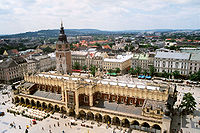A cloth hall or linen hall (German: Gewandhaus; Polish: Sukiennice; French: Halle aux draps; Dutch: Lakenhal) is a historic building located in the centre of the main marketplace of a European town. Cloth halls were built from medieval times into the 18th century.
A cloth hall contained trading stalls for the sale, particularly, of cloth but also of leather, wax, salt, and exotic imports such as silks and spices.
Belgium



Examples of cloth halls in Belgium include the Ypres Cloth Hall and cloth halls in Bruges, Leuven, and Tournai. Leuven's Linen-Hall is in an early-Gothic style, with baroque addition, and now serves as the Leuven University Hall.
- Antoing: the former town hall had been built as a cloth hall in 1565
- Bruges: Kontor of Bruges
- Brussels, see Drapery Court of Brussels
- Dendermonde: Belfry of Dendermonde [nl]
- Diest: Cloth Hall of Diest [nl]
- Tournai: Cloth Hall of Tournai [fr; nl]
- Geel: former city hall
- Ghent: Belfry of Ghent
- Halen: on the site of the current town hall
- Hasselt: Cloth Hall, since the 18th century Meeting House of the Literary Society [nl]
- Heestert: Lakenhalle OLV Hemelvaart
- Herentals: Belfry of Herentals [nl]
- Ypres: Ypres Cloth Hall
- Kortrijk: Great Cloth Hall, destroyed in 1944, now Schouwburgplein.
- Langemark: 1296–1344, destroyed by Ypres weavers
- Leuven: University Hall (Leuven)
- Lier, Belgium: the current Town Hall of Lier [nl].
- Maaseik
- Mechelen: Town Hall of Mechelen [nl]
- Nieuwkerke, demolished in 1844
- Oudenaarde: Oudenaarde Town Hall
- Sint-Truiden: Belfry of Sint-Truiden [fr; nl]
- Tielt: Belfry of Tielt [fr; nl]
- Turnhout: old Town Hall of Turnhout on Herentalsstraat, demolished in 1962
- Zinnik
- Verviers
- Zoutleeuw: Cloth Hall of Zoutleeuw [nl]
Britain and Ireland
British examples are Drapers' Hall, London; the Piece Hall, Halifax; and Leeds' White Cloth Hall.
-
 Piece Hall (cloth hall), Halifax, England
Piece Hall (cloth hall), Halifax, England
-
Surviving part of Leeds' 3rd White Cloth Hall (opened 1775)
In Ireland, the Dublin Linen Hall was completed in 1728, and later White Linen Hall was constructed in Belfast. The Linen Hall Library is located in this area. There were linen halls in other towns such as Castlebar (which includes Linenhall Arts Centre) and Clonakilty.
Germany
Examples of German Gewandhäuser can be found in the towns of Brunswick, Zwickau, and Leipzig.
The rebuilt, third Leipzig Gewandhaus is home to the Leipzig Gewandhaus Orchestra.
-
Gewandhaus (Cloth Hall) in Brunswick, Germany
-
 Gewandhaus (Cloth Hall) in Zwickau, Germany
Gewandhaus (Cloth Hall) in Zwickau, Germany
-
 Rebuilt, third Leipzig Gewandhaus concert hall (opened 1981)
Rebuilt, third Leipzig Gewandhaus concert hall (opened 1981)
Netherlands

The former Cloth Hall in Leiden, Netherlands, has, since the 19th century, housed the Museum De Lakenhal (Municipal Cloth-Hall Museum) of art.
- Amsterdam: cloth hall Groenburgwal, nowadays an Anglican church named Christ Church (Amsterdam) [nl]
- Echt, Netherlands
- Deventer: Wanthuis, part of the Deventer town hall [nl; de] since the 15th/16th century.
- Dordrecht: later called Huis Scharlaeken. Demolished in 1858. The Watersteinstoren used to be part of it for a time.
- Leiden: Laecken-Halle, see Museum De Lakenhal
- Maastricht: Cloth hall at the Market square; linen weavers mainly resided in the Boschstraatkwartier
- Middelburg, Zeeland
- Nijmegen: Gewandhuis/Lakenhal, Great Market square 22–25; the current Kerkboog [nl] is a remnant of it.
- Sittard: at the Market square, destroyed
- Weert. Weerter cloth was also traded in the Halle van Weert in Hoogstraat in Bergen op Zoom and stored in De Stadt van Weert in Reijnderstraat in Antwerp.
Poland
In Poland, the most famous existing cloth-hall building is Kraków's Cloth Hall (Sukiennice), rebuilt in 1555 in Renaissance style. The 14th-century Gothic cloth hall in Toruń is preserved as part of the Old Town Market Hall.
Cloth halls formerly also existed in Poznań, at the Old Market Square; and in Wrocław, at the site of the street now called ulica Sukiennice (Cloth-Hall Street).
-
 Sukiennice (Cloth Hall), Kraków, Poland
Sukiennice (Cloth Hall), Kraków, Poland
-
 Kraków's Sukiennice (Cloth Hall), c. 1870
Kraków's Sukiennice (Cloth Hall), c. 1870
-
Gothic cloth hall in Old Town Market Hall, Toruń, Poland
Notes and references
- Hopkins, Frank (4 September 2008). "The Very Fabric Of Dublin's Past". Irish Independent. Retrieved 31 August 2021.
- Ter Kuile, E.H., & Koch, A.C.F. (1964). Zuid-Salland. Den Haag: Staatsuitgeverij, geraadpleegd van DBNL
- Herwaarden, J., de Boer, D. P., van Kan, F., & Verhoeven, G. (1996). Geschiedenis van Dordrecht tot 1572, pp. 29-30. Gemeentearchief Dordrecht
- "Nijmegen §2.1 Wereldlijke bouwkunst". Encarta Encyclopedie Winkler Prins (in Dutch). Microsoft Corporation/Het Spectrum. 2002.
- J.F.A. Wassink (2005). Van stad en buitenie. Hilversum: Uitgeverij Verloren. p. 280. ISBN 90-6550-850-3. Retrieved 11 April 2023.
- The World's Best Squares, PPS website, Making Places, December 2005